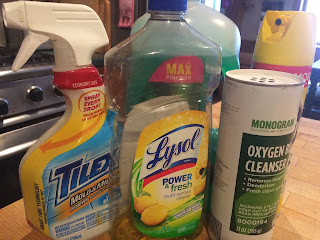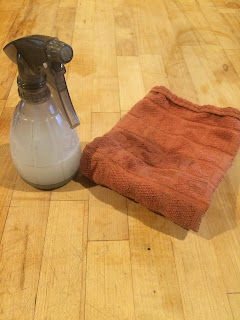Whether you like cleaning and find it to be a cathartic, productive use of your time, or you view it as being an arduous, obligatory task, I’m sure if there’s one thing we can all agree on it’s that we don’t want to expose ourselves, our loved ones, or our environment to unnecessary toxic chemicals whilst cleaning. Ironically, in cleaning our homes using conventional cleaners, we are doing just that—exposing ourselves and others to toxic chemicals and polluting our surfaces, air quality, waste streams, and waterways in the process.
Green, nontoxic housecleaning recipes and products offer a safe, environmentally-friendly alternative to conventional chemical-laden, toxic cleaners.
One of the greatest benefits of greener cleaning products is their ability to improve your home’s air quality. The average person spends 87% of their time indoors, but according to the EPA, the air inside a typical home is 200-500% more polluted than the air outside due in large part to toxic household cleaning products.
Additionally, more than 184,000 tons of household cleaning products are dumped down the drain each year nationwide. That’s equal to over 1,000,000 pounds per day of cleaners containing toxic chemicals that can subsequently pollute our water table, kill wildlife, and pose health risks to the people and pets living in your home.
53% of chemical cleaning products contain ingredients that can harm your lungs. While conventional chemical-based household cleaners are effective and efficient, they are also poisonous if ingested, harmful if inhaled or touched, and contribute to indoor air pollution. Their convenience comes at a price that is too high—both for your personal health and wellbeing and the health and wellbeing of our environment.
Making the switch to alternative green cleaners offers a multitude of benefits such as reducing exposure to airborne toxic chemicals, reducing the incidence of respiratory issues caused by chemical allergens, and reducing the negative environmental impact of toxic household cleaning products. If you choose to make your own green household cleaners rather than purchasing green cleaners, you gain the additional benefits of saving money and reducing packaging waste by reusing spray bottles and containers.
 This week, with help from my fellow environmentalist-at-large sister, Kim, I transitioned my household from conventional chemical cleaning products to green alternatives. Kim spearheaded the homemade cleaners while I purchased green alternatives from the store. In crafting homemade cleaners, Kim utilized a copy of Amy Kolb Noyes’ Nontoxic Housecleaning of the Chelsea Green Guides series. This book provides recipes and tips for making your own green cleaners including air freshener, all-purpose kitchen spray, appliance cleaner, bathroom spray, dish soap, disinfecting spray, furniture polish, glass cleaner, scouring powder, and wood floor polish.
This week, with help from my fellow environmentalist-at-large sister, Kim, I transitioned my household from conventional chemical cleaning products to green alternatives. Kim spearheaded the homemade cleaners while I purchased green alternatives from the store. In crafting homemade cleaners, Kim utilized a copy of Amy Kolb Noyes’ Nontoxic Housecleaning of the Chelsea Green Guides series. This book provides recipes and tips for making your own green cleaners including air freshener, all-purpose kitchen spray, appliance cleaner, bathroom spray, dish soap, disinfecting spray, furniture polish, glass cleaner, scouring powder, and wood floor polish.Kim started her DIY cleaner journey by purchasing two spray bottles—one for glass cleaner and one for kitchen cleaner. (Note: you can also re-purpose conventional cleaner bottles as long as you rinse them out thoroughly).
For the all-purpose kitchen spray, she mixed:
1 Tablespoon castile soap
3 cups water
1 cup vinegar
1 Tablespoon lemon juice
For the glass cleaner, she mixed:
¼ teaspoon castile soap
1 ⅔ cups water
¼ cup vinegar
Both cleaners have worked great! The all-purpose kitchen cleaner has gotten a lot of use. The vinegar component of it cuts through grease, and the lemony scent leaves our kitchen smelling nice and clean.
As an additional waste-saving measure, use reusable dish rags for cleaning rather than single-use paper towels.
 With the glass cleaner, using a small swath of old newspaper, a squeegee, or a lint-free cotton cloth are all viable alternatives to wasteful single-use paper products. I used newspaper when using the glass cleaner and
With the glass cleaner, using a small swath of old newspaper, a squeegee, or a lint-free cotton cloth are all viable alternatives to wasteful single-use paper products. I used newspaper when using the glass cleaner and it left my mirrors squeaky clean and streak free. Best of all, I didn’t feel panicked when some of the spray dripped onto my hands and sprayed into my face.
When searching for the best soap to use in your homemade cleaner, Dr. Bronner’s is an ideal brand of castile soap because it is widely available, made with organic oils, is certified fair trade, is not tested on animals, and is available already scented with essential oils (if using unscented castile, soap, add 8-10 drops of your favorite essential oil per batch).
 Generally speaking, main ingredients you need for household cleaners include baking soda, white vinegar, soap, borax, lemon juice, water, club soda (great for getting out stains on clothes, carpet, and upholstery), and salt. You can look to a guide like Noyes’ Nontoxic Housecleaning or find a lot of ideas and recipes on the internet.
Generally speaking, main ingredients you need for household cleaners include baking soda, white vinegar, soap, borax, lemon juice, water, club soda (great for getting out stains on clothes, carpet, and upholstery), and salt. You can look to a guide like Noyes’ Nontoxic Housecleaning or find a lot of ideas and recipes on the internet.If you’re not one for doing it yourself, you can also seek pre-made green cleaning products in stores. This week I purchased green dish soap and dishwasher pods. The key in searching for green cleaners is to look for products that are dye and fragrance free, chlorine free, phosphate free, made from plant-based ingredients (rather than petroleum-based ingredients), and are biodegradable. If the products contain warning labels such as “Caution!” “Danger!” or “May cause burns” they are neither green nor safe to bring into your home.
For additional insight, information, and product recommendations, consider taking a look at this Green Guide to household cleaning supplies from the Organic Consumers Association
Our homes should be places of solace, respite, safety, health, and relaxation—not places coated in and polluted by caustic, toxic cleaning agents. A clean home is a happy home, but a green/clean home is a happier home!
I encourage you to make the switch to green cleaning agents—not only for the environment, but for your health and wellbeing as well. Reducing your waste and exposure to chemicals by making your own cleaning products or investing in green alternatives feels immensely satisfying. It’s a switch we should have made years ago, but it’s better late than never.
As always, feel free to share your thoughts, experiences, homemade cleaner recipes, and more in the comments section below. Nontoxic housecleaning is just one step, but an important one, on the journey toward greener living.
Join me next week as I endeavor to green my hygiene routine: from beauty products, to water usage, to toilet paper—it’ll be a blog you won’t want to miss!
~Sam



No comments:
Post a Comment
Note: Only a member of this blog may post a comment.